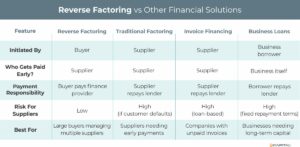
Reverse Factoring: A Smart Financing Solution for Supply Chain Stability
Content
Managing cash flow in a supply chain can be challenging, especially for suppliers who often face delayed payments from buyers. Reverse factoring (also known as supply chain finance) is an innovative financing solution that benefits both buyers and suppliers by allowing suppliers to get paid faster while enabling buyers to extend their payment terms.
Unlike traditional factoring, where suppliers sell their invoices to a third party for early payment, reverse factoring is initiated by the buyer to ensure suppliers receive their payments quickly. In this blog, we’ll explore how reverse factoring works, how it compares to other financing options, and provide a real-world example to illustrate its benefits.
What is Reverse Factoring?
Reverse factoring is a financing arrangement where a buyer partners with a financial provider to ensure that their suppliers receive early payments. This helps suppliers improve cash flow without negatively affecting the buyer’s payment cycle.
How Reverse Factoring Works
- A supplier delivers goods or services and issues an invoice to the buyer.
- The buyer approves the invoice and sends it to the financing provider.
- The financing provider pays the supplier early (at a discounted rate).
- The buyer repays the financing provider later, according to the agreed payment terms.
This arrangement benefits both parties – the supplier gets paid faster, while the buyer maintains longer payment terms, improving overall financial health across the supply chain.
Key Differences
- Reverse Factoring vs. Traditional Factoring:
- In traditional factoring, the supplier sells their unpaid invoices to a factoring company to receive early payment.
- In reverse factoring, the buyer arranges the financing, ensuring that the supplier receives early payment with lower financing costs.
- Reverse Factoring vs. Invoice Financing:
- Invoice financing is a loan against unpaid invoices, where the supplier is responsible for repayment.
- Reverse factoring does not require suppliers to take on debt, as the buyer is responsible for paying the financing provider.
- Reverse Factoring vs. Business Loans:
- Business loans require fixed monthly repayments and credit assessments.
- Reverse factoring is tied directly to invoices, reducing risk and providing flexible payment options.
Example of Reverse Factoring in Action
Scenario: A Retail Chain and Its Suppliers
Company: A national retail chain (buyer) works with multiple suppliers who provide packaged food products.
Problem: Suppliers struggle with cash flow delays due to the retailer’s 90-day payment terms.
Solution: The retailer partners with a financing provider and implements a reverse factoring program.
- When suppliers issue invoices, the financing provider pays them immediately instead of 90 days.
- The retailer repays the financing provider on the original 90-day schedule.
Outcome:
- Suppliers receive faster payments, improving their financial stability.
- The retailer maintains long payment terms without disrupting supply chain relationships.
- The financing provider earns a small fee, making it a win-win arrangement.
Benefits of Reverse Factoring
For Buyers (Large Companies)
- Strengthens Supplier Relationships – Ensures that suppliers have steady cash flow, reducing the risk of supply chain disruptions.
- Extends Payment Terms – Buyers can negotiate longer payment terms without negatively affecting suppliers.
- Reduces Supplier Costs – Suppliers access lower-cost financing, which can result in better pricing and quality from suppliers.
For Suppliers
- Improves Cash Flow – No more waiting for extended payment terms; suppliers get paid quickly.
- Reduces Credit Risk – Suppliers don’t need to take out loans or rely on expensive factoring arrangements.
- Strengthened Buyer-Supplier Relationships: Reverse factoring can enhance the relationship between buyers and suppliers by providing financial support and stability, helping to strengthen supply chains.
Challenges of Reverse Factoring
- Requires Strong Buyer Creditworthiness – Lenders only participate in reverse factoring if the buyer has a strong financial position.
- Not Suitable for Small Buyers – Reverse factoring is most effective for large corporations working with multiple suppliers.
- May Require Process Adjustments – Businesses must integrate the financing provider into their payment process, which could involve system updates.
When Should a Business Consider Reverse Factoring?
Reverse factoring is ideal for:
- Large corporations that work with many suppliers and want to optimize payment terms.
- Companies with strong credit ratings that can negotiate low-cost financing solutions.
- Industries with long supply chains, such as retail, automotive, and manufacturing.
Conclusion
Reverse factoring is an efficient, low-risk financing solution that benefits both buyers and suppliers. By enabling early payments while maintaining extended payment terms, businesses can build stronger supplier relationships, reduce supply chain risks, and optimize working capital.
If your business works with multiple suppliers and faces cash flow challenges, consider implementing a reverse factoring program to improve financial efficiency and supply chain stability.
Contact us to explore cash flow solutions to strengthen supply chains and financing options to fuel business growth.
Key Takeaways
- Suppliers often deal with extended or delayed payments from buyers, disrupting their cash flow and weakening the supply chain.
- Reverse factoring is a financing arrangement where a buyer partners with a financial provider to ensure that their suppliers receive early payments.
- By enabling early payments while maintaining extended payment terms, businesses can build stronger supplier relationships, reduce supply chain risks, and optimize working capital.
ABOUT eCapital
At eCapital, we accelerate business growth by delivering fast, flexible access to capital through cutting-edge technology and deep industry insight.
Across North America and the U.K., we’ve redefined how small and medium-sized businesses access funding—eliminating friction, speeding approvals, and empowering clients with access to the capital they need to move forward. With the capacity to fund facilities from $5 million to $250 million, we support a wide range of business needs at every stage.
With a powerful blend of innovation, scalability, and personalized service, we’re not just a funding provider, we’re a strategic partner built for what’s next.



